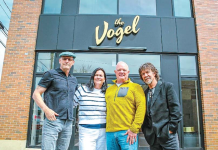
Volunteers for the experimental vaccine for COVID-19 received a package containing a pulse oximeter, a thermometer and a kit for an at-home nasal swab to monitor themselves.
By Marion Lynch
“Volunteers Needed: A COVID-19 clinical research study is now recruiting in your area. You may be eligible to take part in the ENSEMBLE Study if you are at least 18 years old. The study sponsor is looking for people interested in learning more about participating in the study.”
Days after this email landed in my inbox, I volunteered to participate in the Phase 3 trial of Janssen Pharmaceutical’s experimental vaccine for COVID-19.
That same day, New Jersey reported 4,661 new cases in the state and confirmed 50 more deaths from COVID-19. With hospitalizations and deaths increasing in the state, and with 10 days to go before the first vaccine received approval from the Food and Drug Administration, the outlook was grim.
What could I do to help? I don’t have the training or skills needed to cure disease or save lives. I don’t have the ability to write large checks to fund research. So, I did what I could do. I rolled up my sleeve and hoped that I could play a small part in bringing about an end to the pandemic.
On Dec. 1, 2020 I became one of 45,000 worldwide participants testing the safety and efficacy of Janssen’s investigational COVID-19 vaccine. Locally, the trial is conducted by the Robert Wood Johnson Medical School at Rutgers University.
I arrived at the facility in New Brunswick and went through a detailed medical history with my clinician. After checking my blood pressure and other vitals, three vials of blood were drawn and I was taught how to do a nasal swab at home.
After a brief wait, I received a shot in my right arm. Since this is a randomized, double-blind study, there’s a 50 percent chance that I received the vaccine and a 50 percent chance that I received a saline-solution placebo.
I sat for 15 minutes to be monitored for any adverse reactions, downloaded the study app on my phone and was sent home with a box containing a pulse oximeter, a thermometer and a kit for an at-home nasal swab.
On Day 2, I woke up, disappointed that I wasn’t experiencing any symptoms that I had read that some other study volunteers had reported: no headache, no fever, no flu-like symptoms. Did I get the placebo? Since not everyone experiences reactions to the vaccine, I have no way of knowing, so I’ll continue the standard protocol of social distancing, mask wearing and handwashing.
Three times a day, I check my heart rate and oxygen level and record it in the E Diary on the study app. Once a day, I take my temperature and report any symptoms I may have such as fever, headache, loss of taste or smell or discoloration of my feet.
I returned to New Brunswick on Day 29 for more blood draws and schedule my next appointment for Day 71. According to Johnson & Johnson, parent company of Janssen, researchers expect the vaccine to result in full immunity at 28 days.
Although the Phase 3 study will last for two years, Johnson & Johnson expects to seek authorization for emergency use next month. Once the FDA grants approval, it will join the other vaccines already approved and in use.
Unlike the two vaccines from Pfizer and Moderna, Janssen’s vaccine will not require super cold temperatures for transportation and storage. It can remain stable for three months at 35-46 degrees, like in a household refrigerator. With a longer shelf life, the vaccine will be easier to distribute without special cold storage equipment.
Unlike Pfizer and Moderna’s mRNA vaccines, which use messenger RNA to create a protein that prompts an immune response, Janssen’s vaccine uses an adenovirus – a type of virus that causes the common cold – that has been made unable to replicate. The adenovirus carries a coronavirus gene which then produces the coronavirus spike protein, but not the coronavirus itself. This spike protein is what primes the immune system to fight off a subsequent infection by the virus.
Johnson & Johnson says adenorvirus vaccines have been used before for Ebola, and experimental vaccines for HIV and RSV, so there is much long-term safety data available. The company hopes that their vaccine will be at least 90 percent effective in preventing moderate to severe symptoms of COVID-19.
As we wait for vaccines to be widely available to the public, I’m grateful for the scientists and researchers around the world who are working tirelessly to get this pandemic under control. When we can return to the things we’ve missed – seeing our friends and family, hugging without fear, going to concerts and movies, and the more mundane routines of our former everyday lives – I’ll feel just a little proud that I was able to play a very small part in the solution.
Writer and former Two River Times editor Marion Lynch lives in Ocean. She excels at social distancing and can’t wait to hug her grandson in Switzerland.
The article originally appeared in the January 7 – 13, 2021 print edition of The Two River Times.














